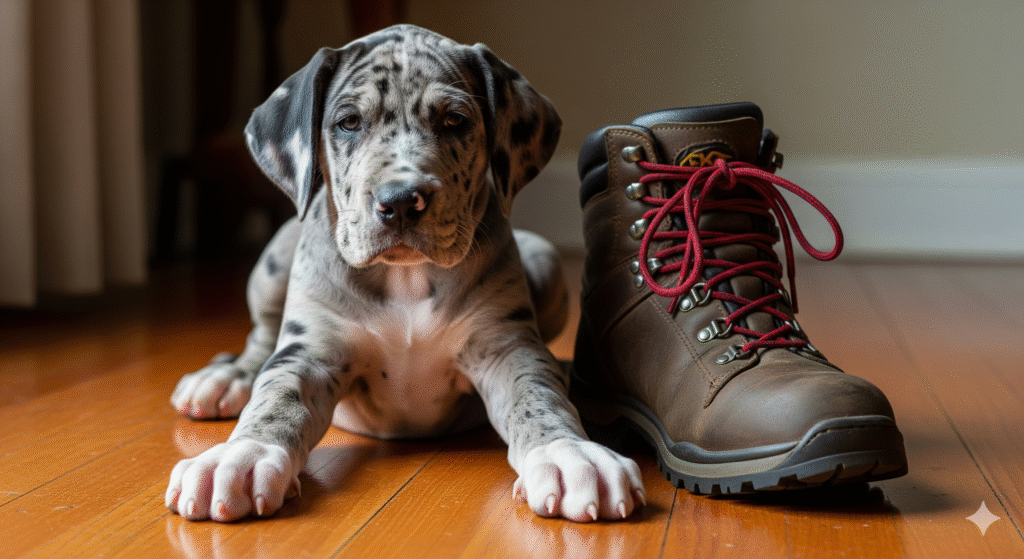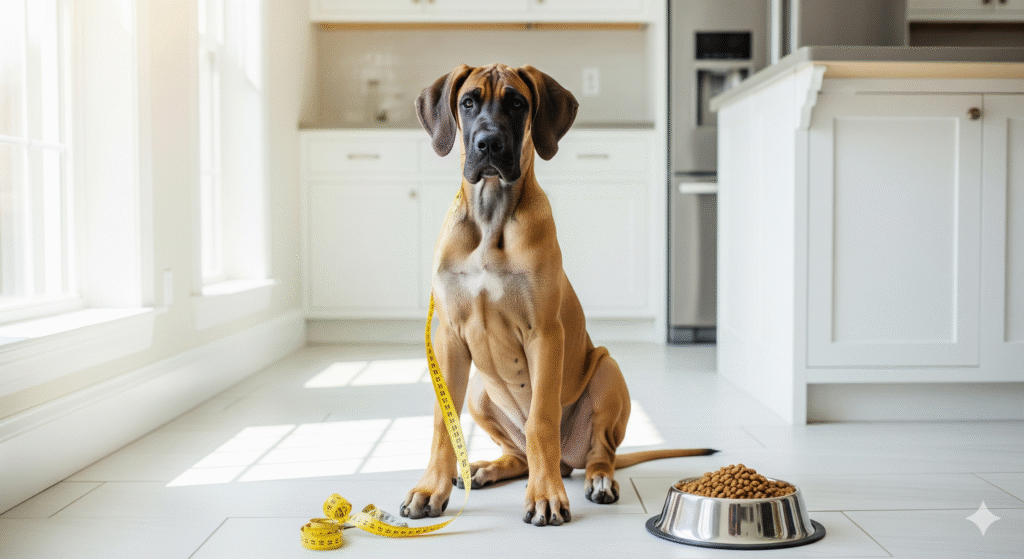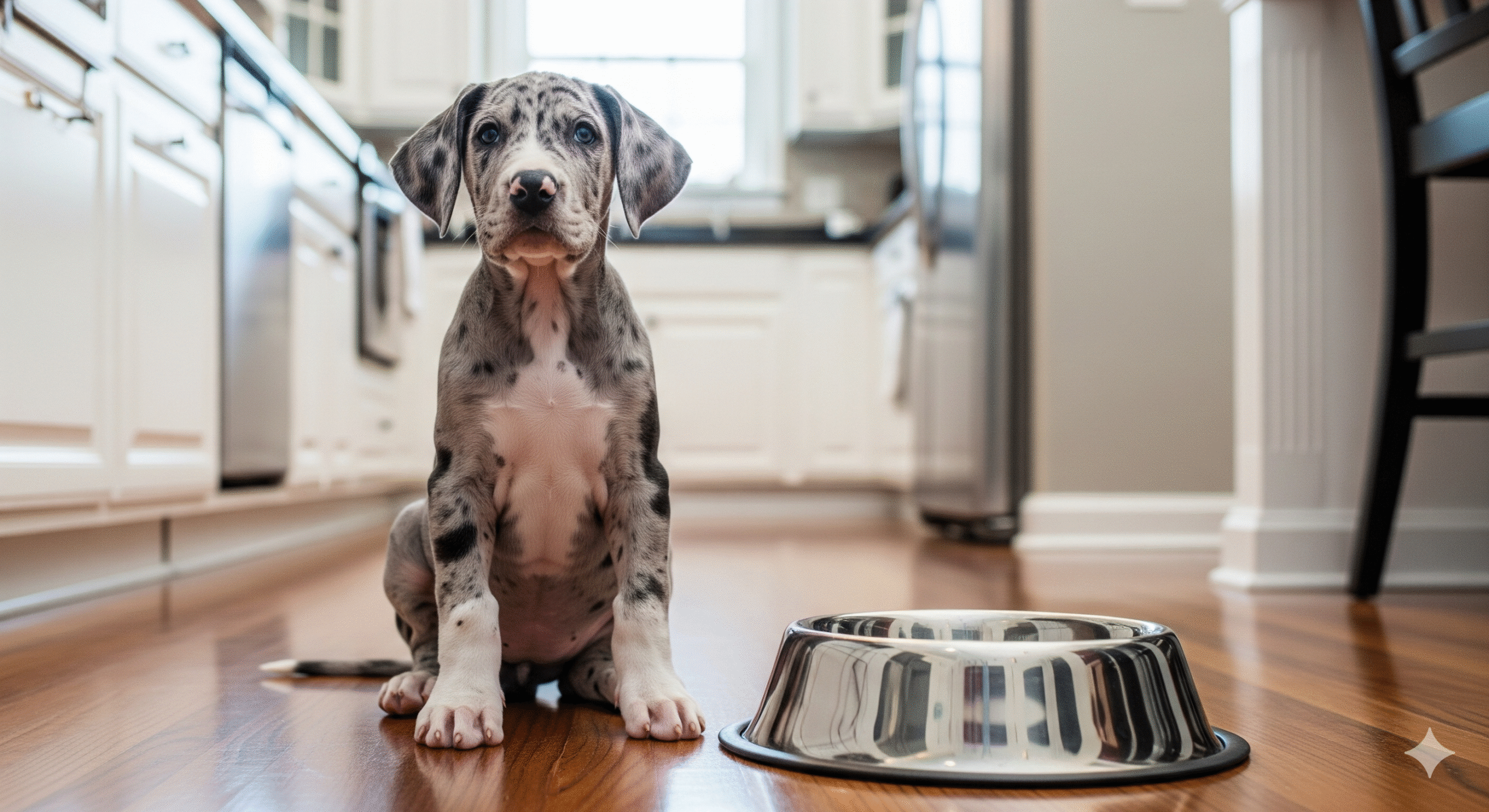Welcome to the wonderful world of Great Danes! Bringing one of these gentle giants into your home is an unparalleled experience. From the moment you pick up that clumsy, oversized furball, you’re embarking on a journey of rapid growth and immense love. But raising one of the world’s largest dog breeds comes with a unique set of responsibilities, especially concerning their development. For these magnificent large breeds, proper nutrition isn’t just about filling their belly—it’s the fundamental building block for a long, healthy, and happy life.
Watching a Great Dane puppy grow is a marvel of nature. They can go from a mere 1-2 pounds at birth to upwards of 150 pounds in just 18 months. This explosive growth phase is a delicate time. The right diet and care will build a strong musculoskeletal system, while the wrong approach can unfortunately lead to serious health complications. This guide is your roadmap to navigating the crucial first two years of your Great Dane’s life, ensuring their journey to adulthood is as smooth and healthy as possible.
Understanding the Great Dane Growth Curve 📏
Unlike smaller breeds, the growth of a Great Dane puppy is a carefully managed marathon, not a sprint. Their skeletal structure is under immense pressure as it develops at an astonishing rate. Growing too quickly is one of the biggest dangers for a Great Dane puppy. This rapid growth, often fueled by an improper diet, puts them at a high risk for Developmental Orthopedic Diseases (DODs).
These painful conditions affect the normal development of bones and joints and can include:
- Hypertrophic Osteodystrophy (HOD): Inflammation in the growth plates of the long bones, causing fever, pain, and lameness.
- Osteochondrosis (OCD): A condition where cartilage in the joints doesn’t develop properly, leading to lameness and arthritis.
- Panosteitis: A painful inflammation of the outer surface of the long bones, often called “growing pains.”
The key takeaway is that slower, steadier growth is always healthier for a Great Dane. Your goal isn’t to have the biggest puppy at the park; it’s to have the healthiest adult dog in the years to come.
Great Dane Puppy Growth Chart (By Weight & Height)
While every puppy is an individual, growth charts can be a helpful tool to ensure your pup is on a healthy track. Remember, these are averages—genetics, diet, and individual metabolism will cause variations. Always consult your vet if you have concerns.
| Age (Months) | Average Weight (lbs) – Male | Average Weight (lbs) – Female | Notes |
| 2 | 25 – 35 lbs | 20 – 30 lbs | Rapid initial growth phase. |
| 3 | 40 – 55 lbs | 35 – 45 lbs | Paws will look very oversized! |
| 4 | 60 – 75 lbs | 50 – 65 lbs | Growth continues at a fast pace. |
| 5 | 75 – 90 lbs | 65 – 80 lbs | Entering the “lanky” adolescent stage. |
| 6 | 90 – 110 lbs | 80 – 95 lbs | Gaining around 3-5 lbs per week. |
| 8 | 100 – 130 lbs | 90 – 110 lbs | Growth rate begins to slow down. |
| 12 | 120 – 150 lbs | 100 – 125 lbs | Nearing full height. |
| 18 | 140 – 175 lbs | 110 – 140 lbs | Reached full height; will continue to fill out. |
Instead of focusing on hitting exact numbers, pay attention to your puppy’s body condition. You should be able to feel their ribs easily without them protruding, and they should have a visible “waist” when viewed from above.

The Pillars of Great Dane Puppy Nutrition 🍖
Nutrition is the single most important factor you can control to ensure your Great Dane develops strong bones and healthy joints. The unique needs of large breeds mean you can’t just pick any bag of puppy food off the shelf.
Choosing the Right Food: What to Look For
Always, without exception, feed your Great Dane puppy a food specifically formulated for large-breed puppies. This is non-negotiable. These specialized formulas are designed to support controlled growth through a carefully balanced nutrient profile.
Here’s what to look for on the label:
- Formulated for Large-Breed Puppies: The bag should state this clearly. This indicates it meets the specific AAFCO (Association of American Feed Control Officials) guidelines for the growth of large-size dogs.
- High-Quality Animal Protein: Look for named meat sources like deboned chicken, lamb, or fish as the first ingredient. Protein is vital for muscle development. The ideal range is generally between 23-28% protein on a dry matter basis.
- Moderate Fat and Calories: Too many calories fuel growth that is too rapid. A fat content between 12-18% is typically recommended to provide energy without excess.
- Balanced Calcium-to-Phosphorus Ratio: This is perhaps the most critical element. Excess calcium is a primary contributor to DODs in giant breeds. The food should have a calcium content of around 1.2-1.5% and a calcium-to-phosphorus ratio close to 1.2:1. Never choose a food with a calcium level above 1.8% for a Great Dane puppy.
- Joint-Supporting Ingredients: Many premium large-breed puppy foods include beneficial additives like glucosamine and chondroitin to support cartilage and joint health from an early age.
How Much to Feed Your Great Dane Puppy?
The feeding guidelines on the back of the dog food bag are just a starting point. Your puppy’s activity level, metabolism, and individual needs will determine the right amount.
- Follow a Schedule: For young puppies (2-6 months), split their total daily food amount into 3-4 smaller meals. This helps with digestion and maintains stable energy levels. As they get older, you can transition to 2 meals per day.
- Monitor Body Condition: The best way to determine the right amount is by monitoring their physical shape. Regularly run your hands along their sides. A healthy, lean puppy will have ribs you can easily feel but not see. If you can’t feel the ribs, you may be overfeeding. If the ribs are highly visible, you may be underfeeding.
- Adjust as They Grow: You will need to periodically adjust the amount of food as your puppy grows. Consult your vet and use your puppy’s body condition as your primary guide.
The Dangers of Overfeeding and Free-Feeding
It can be tempting to keep the bowl full for a growing pup, but free-feeding is a major risk for Great Danes. This practice, where food is left out all day, makes it impossible to monitor your puppy’s caloric intake and almost always leads to overconsumption. This excess energy fuels dangerously fast growth. Stick to measured, scheduled meals to keep your puppy lean and healthy.
Common Nutritional Mistakes to Avoid ❌
With so much information out there, it’s easy to make a mistake with the best of intentions. Here are the most critical things to avoid.
Supplementing with Calcium
Never add a calcium supplement to your Great Dane puppy’s diet. A high-quality, large-breed puppy food is already perfectly balanced. Adding extra calcium disrupts the delicate calcium-to-phosphorus ratio, which can accelerate bone growth abnormally and cause severe skeletal malformations. Trust the science behind the formulated food.
Feeding Adult Dog Food Too Soon
Adult dog food does not have the correct nutritional balance to support a growing Great Dane puppy. The protein, fat, and calorie levels may be inappropriate, and most critically, the calcium and phosphorus levels are formulated for maintenance, not for growth, putting your puppy at risk.
Giving Too Many Treats & Table Scraps
Treats are great for training, but they contain calories. A good rule of thumb is the 10% rule: treats should make up no more than 10% of your puppy’s total daily caloric intake. Choose healthy, low-calorie treats, and avoid giving fatty table scraps, which can lead to pancreatitis and an unbalanced diet.
Transitioning to Adult Food 🐾
Great Danes are considered puppies for a long time. They typically don’t reach their full musculoskeletal maturity until they are 18 to 24 months old. You should continue feeding them their large-breed puppy formula until this point. Consult your veterinarian to determine the best time to make the switch to an adult formula for large breeds.
When it’s time to transition, do it gradually to avoid digestive upset:
- Days 1-3: 75% puppy food, 25% adult food.
- Days 4-6: 50% puppy food, 50% adult food.
- Days 7-9: 25% puppy food, 75% adult food.
- Day 10: 100% adult food.
The Role of Exercise in Healthy Growth 🏃♂️
Proper exercise is just as important as nutrition. While your puppy has boundless energy, their joints and growth plates are very delicate. Growth plates are soft areas of developing cartilage at the ends of the long bones, which don’t fully close and harden until around 18 months of age. High-impact or forced exercise can damage them.
Do’s and Don’ts of Puppy Exercise
- ✅ DO allow for short, frequent walks and free-play sessions in a safely fenced area.
- ✅ DO encourage play on soft surfaces like grass rather than hard pavement.
- ✅ DO enroll in puppy socialization classes for safe, supervised interaction.
- ❌ DON’T take your puppy on long-distance runs or jogs until they are at least 18 months old.
- ❌ DON’T allow them to jump from high surfaces like trucks, decks, or furniture.
- ❌ DON’T engage in activities that involve lots of tight turns or sudden stops, like frisbee.
When to Consult Your Veterinarian 🩺
Building a strong relationship with a veterinarian who is knowledgeable about giant breeds is crucial. They are your best resource. Be sure to schedule a visit if you notice any of the following:
- Limping, stiffness, or reluctance to play.
- Swollen or painful joints.
- Any sign of bowed legs.
- Sudden weight gain or loss.
- Persistent digestive issues like vomiting or diarrhea.
A Commitment to Healthy Growth
Raising a Great Dane puppy is a profound commitment, but the rewards are immeasurable. By providing a foundation of superior nutrition tailored to large breeds, monitoring their growth, and ensuring their exercise is safe and appropriate, you are giving them the greatest gift of all: the promise of a long, healthy life as your loyal and loving companion
What has been the most surprising part of your Great Dane puppy’s growth journey? Share your stories and questions in the comments below! For more expert tips on raising happy and healthy puppies, subscribe to our newsletter.

…Asking these ten questions will give you confidence that you’re working with a responsible breeder. Once you’re satisfied with the answers and have met the puppies, the final step is to choose your perfect companion. To help you in that crucial moment, use our guide on Puppy Temperament Tests: What to Look For.






